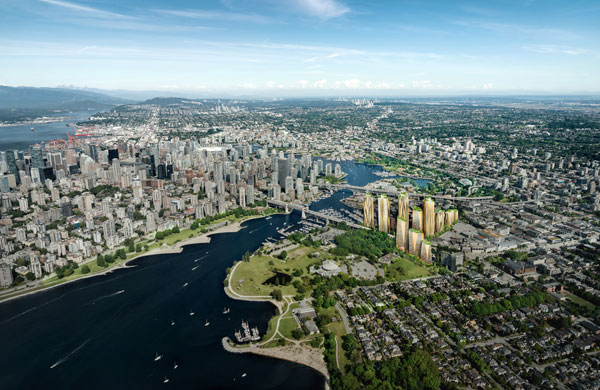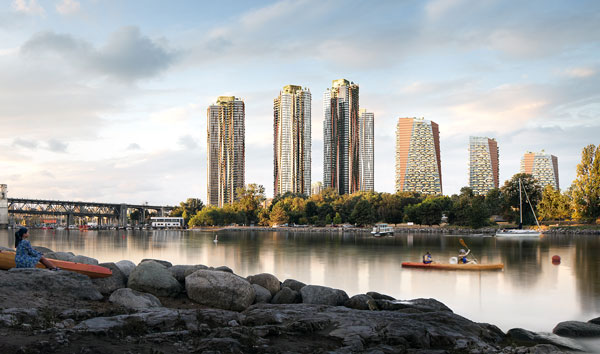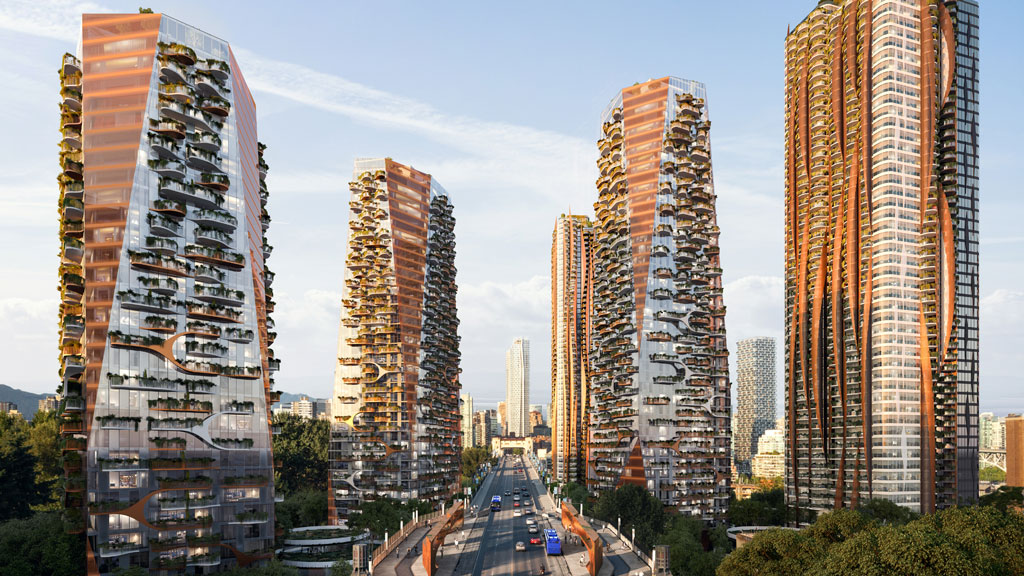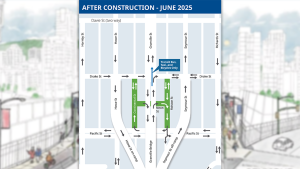Prep work has begun for a massive project that will eventually see more than 6,000 homes and rental units built on traditional First Nations lands at the head of False Creek in the Kitsilano neighbourhood of Vancouver.
Remedial excavation of contaminated soils along previous railway lines has begun and crews are starting on bulk excavation work for phase one of the project.
The L-shaped parcel of land which straddles both sides of the Burrard Bridge was once an ancient village forcibly taken away from the Squamish First Nation more than a century ago but subsequently returned by the courts in 2003.
The new development will be the largest Indigenous-led economic project in Canadian history and the largest net-zero residential project in Canada, consisting of 11 towers ranging in height from 12 to 58 storeys. Ten of the towers will be mainly for residential use. They will have commercial space on the ground floors.
The development will feature Coast Salish architecture and design across a 10-acre site. Roughly 400 of the units will be for Squamish Nation members.

“The residential towers’ exterior design will resemble the longhouses that existed in the previous Senakw village,” explains Connor Trembley, a spokesperson for the Squamish Nation. “Moreover, their wavy balconies will be inspired by the nation’s traditional art.”
There will also be Coast Salish architecture in interior spaces of the buildings, in public areas, rental units and signs.
“These designs will reflect our cultural values and traditions,” says Trembley. “The designs are important because they will help to remind people that they’re on our traditional territory and intrigue them to learn more about our culture.”
The project is being done in four phases. The first residents are expected to move in in 2025 and the entire project should be completed by 2029. The development will consist of 2,634 studios, 2,034 one-bedroom, 868 two-bedroom and 490 three-bedroom units. Many of the units will be rental.
The project is important for Squamish First Nation because it is expected to generate an estimated long-term return of more than $10 billion, mainly from the rentals and business leases in the 10 towers.
The development will “generate billions of dollars in annual revenue so we can become more financially independent,” says Trembley, noting it will create jobs for our members in the construction, design and security sectors.
The development will achieve the goal of providing housing to every member of the Squamish Nation within a generation and densify the housing stock so more members can secure accommodation, he says.
The project will include stores so Vancouverites can shop locally, a new day care centre, and new cycling lanes and walkways to provide better connectivity to the Kitsilano area and Burrard Street Bridge.

New green spaces and public spaces will also be created to revitalize the area. Squamish First Nation intends to invite the public to attend some of its events and ceremonies at plazas on the site to showcase how humanity and nature can co-exist. Trees and other plants will be put along sidewalks and pathways.
The proposed form of the development has been inspired by the unique location and historic context of the site, and the deep embrace of nature by the Squamish Nation – the mountains, forest and water, and craftwork traditions of carving and weaving – which resulted in two distinct typologies of buildings whose paths converge at the foot of the Burrard Street Bridge.
To achieve the goal of net-zero, many of the buildings will be made from mass timber, which generates less carbon than cement. All of the development’s heating and cooling will be produced by a 10-megawatt district energy system fed by waste heat from Metro Vancouver’s adjacent sewer infrastructure.
An official groundbreaking was held at the site earlier this fall. Delegates from both the Squamish Nation and federal government attended. The federal government has committed $1.4 billion for the first two phases of the project.The economic partnership is the largest in Canadian history between a First Nation and the federal government and the largest loan ever from the Canada Mortgage and Housing Corporation. It is through the Rental Construction Financing Initiative launched in 2017 which provides low-interest, repayable loans to support large-scale residential construction projects that encourage a stable supply of rental housing for middle-income families in expensive housing markets.
Squamish Nation says in a statement the federal government is helping to define a new generation of First Nations reconciliation and leadership, grow the economy and create good jobs.
“We will continue to work together to advance meaningful reconciliation, including economic reconciliation, and ensure everyone has a safe place to call home,” the statement reads.
Squamish Nation council chairperson Khelsilem, who uses one name, said the partnership to support the residential development is a historic moment in Canada’s relationship with Indigenous communities.
“This investment will build many needed rental apartments and generate long-term wealth for Squamish people across many generations. The wealth generated from these lands can then be recirculated into our local economies and communities to address our people’s urgent needs for affordable housing, education, and social services.”











The residential towers resembling ‘longhouses’ and ‘wavy balconies’ intended to reflect traditional Senakw design better be convincing or could prove to be a serious visual blight at a key entry to the City. As for ‘trees and other plants’ located along pathways – really?
Kudos to the Squamish Nation for their persistent endeavors to make this major development a reality!!!! I am sure that your members will be appreciative of your efforts to see this project become home of your TRADITIONAL TERRITORY….
The fruit of numerous meetings by the Squamish Councilors and Federal government will benefit All Of The People throughout the world!!!!
AT
Love to help with your project